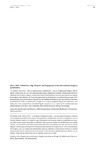Mostrar o rexistro simple do ítem
Roma 1935: arquitectura, ciudad, retórica y propaganda en el Congreso Internacional de arquitectos
| dc.contributor.author | Alonso Pereira, José Ramón | |
| dc.date.accessioned | 2023-04-27T10:34:07Z | |
| dc.date.available | 2023-04-27T10:34:07Z | |
| dc.date.issued | 2022 | |
| dc.identifier.citation | Alonso Pereira. (2022). Roma 1935: arquitectura, ciudad, retórica y propaganda en el Congreso Internacional de arquitectos = Rome 1935: Architecture, City, Rhetoric and Propaganda in the International Congress of Architects. Cuaderno de Notas, 23, 38–55. https://doi.org/10.20868/cn.2022.4983 | es_ES |
| dc.identifier.issn | 1138-1590 | |
| dc.identifier.issn | 2386-8376 | |
| dc.identifier.uri | http://hdl.handle.net/2183/32954 | |
| dc.description.abstract | [Resumen] El periodo entre 1922 y 1943 —el llamado ventenio fascista— fue una época fecunda y creativa en la arquitectura italiana. Sus bases ricas y plurales establecieron relaciones singulares entre el mundo cultural clásico y el moderno, que trascienden su momento histórico y plantean en nues-tros días nuevos temas de análisis y reflexión. Para conocer y valorar su arquitectura y su modelo urbano, nos serviremos del viaje al que fueron llevados los profesionales que de todo el mundo llegaron a Roma para participar en el Congreso Internacional de Arquitectos en 1935, considerando el Congreso como un espacio de oportunidad para esa reflexión y tomando las visitas a la ciudad programadas por los organizadores como fuente de los intereses arquitectónicos y urbanos de su tiempo, reflejo de las tendencias que se agitaban entonces en Italia. | es_ES |
| dc.description.abstract | [Abstract] The period 1922-1943 —the so-called fascist venthenium— was a fruitful and creative time in Italian architecture. Its rich and plural fundamentals established singular relationships between classical and modern cultures, which transcends their historical moment and present new topics for analysis and reflection. To know and appreciate its architecture, we will use the journeys of the professionals who came to Rome from all over the world to participate in the International Congress of Architects in 1935, considering the Congress as a space of opportunity for that reflection, and taking the visits around Rome scheduled by the organizers as a source of the architectural and urban interests of its time, and a reflection of the trends that were stirring then in Italy. | es_ES |
| dc.language.iso | spa | es_ES |
| dc.publisher | Universidad Politécnica de Madrid: Escuela Técnica Superior de Arquitectura | es_ES |
| dc.relation.uri | https://doi.org/10.20868/cn.2022.4983 | es_ES |
| dc.rights | Atribución-NoComercial-SinDerivadas 3.0 España | es_ES |
| dc.rights.uri | http://creativecommons.org/licenses/by-nc-nd/3.0/es/ | * |
| dc.subject | Arquitectura y urbanismo | es_ES |
| dc.subject | Arquitectura italiana del siglo XX | es_ES |
| dc.subject | Modernidad | es_ES |
| dc.subject | Racionalismo | es_ES |
| dc.subject | Novecentismo | es_ES |
| dc.subject | Era monumental | es_ES |
| dc.subject | Architecture and Urbanism | es_ES |
| dc.subject | 20th Century Italian Architecture | es_ES |
| dc.subject | Modernism | es_ES |
| dc.subject | Novecentism | es_ES |
| dc.subject | Monumental Era | es_ES |
| dc.title | Roma 1935: arquitectura, ciudad, retórica y propaganda en el Congreso Internacional de arquitectos | es_ES |
| dc.title.alternative | Rome 1935: Architecture, City, Rhetoric and Propaganda in the International Congress of Architects | es_ES |
| dc.type | info:eu-repo/semantics/article | es_ES |
| dc.rights.access | info:eu-repo/semantics/openAccess | es_ES |
| UDC.journalTitle | Cuaderno de notas | es_ES |
| UDC.issue | 23 | es_ES |
| UDC.startPage | 38 | es_ES |
| UDC.endPage | 55 | es_ES |
Ficheiros no ítem
Este ítem aparece na(s) seguinte(s) colección(s)
-
GI- IALA - Artigos [20]






